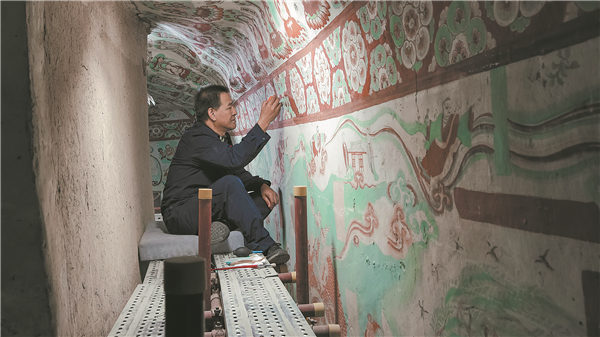

Documentary's second season shines an intriguing light on those who work in Mogao Caves, Xu Fan reports.
Near the end of July, during peak tourist season, the Mogao Caves in Dunhuang, Gansu province, were bustling with tourists. However, a small team of mural restorers quietly carried out their routine, seemingly undisturbed by the constant stream of visitors just a short distance away from their workplace — Cave 196.
Yet to be opened to the public, the cave, which dates back to the late Tang Dynasty (618-907), is situated on the top floor of the cliffs that were carved into the Mogao Caves, the world-renowned treasure house of Buddhist art.
Yang Tao, a seasoned grotto restorer who has worked in Dunhuang for more than three decades, ascends the stairs to the cave each day as part of his essential routine.
His regular job, most of the time, includes coaching apprentices, with the youngest born in the 2000s, checking the damaged areas, and researching restoration methods. Additionally, Yang sometimes examines recorded videos from the infrared cameras to see if there are any uninvited "guests", for instance, a curious pheasant or a naughty stray cat.
Even during his spare time, the veteran demonstrates his passion for Dunhuang and its distinctive landscape. He heads into the Gobi Desert, taking aimless strolls and collecting seemingly useless items, ranging from dried poplar branches to stones, as "souvenirs".
His story is featured in the first episode of The Master of Dunhuang, a Tencent News documentary franchise that began streaming its second season online on Oct 11.
Continuing in the style of the first season, which aired last year and attracted a large viewership, the new season sheds light on ordinary people dedicated to preserving the centuries-old grottoes and the heritage of Dunhuang culture. It consists of six episodes that recount three tales about grotto restorers, the artists who replicate murals, and tour guides, respectively.
For Yang, one of Dunhuang's most experienced restorers who still works on-site, restoration work is akin to performing intricate surgery. He meticulously tends to the damaged parts, treating them with care and attention, as if they were elderly patients in need of surgery.